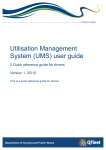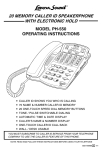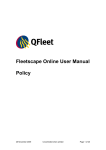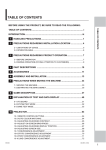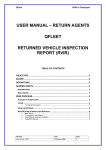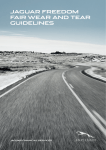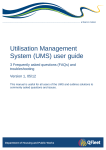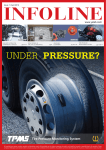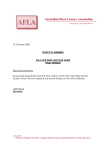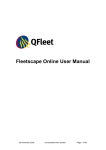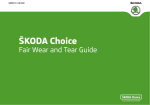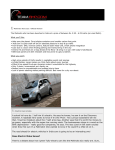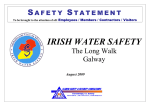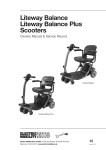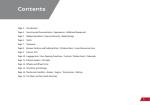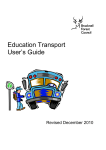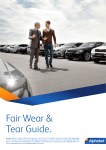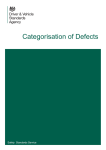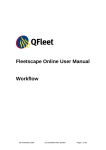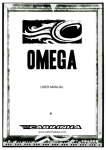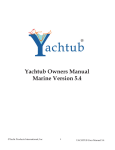Download Your guide to fair wear and tear
Transcript
QFleet Your guide to fair wear and tear Updated April 2007 Directory | Introduction | Interior | Exterior | Returning your vehicle 02 Directory Introduction 03 Interior Dashboard and console 04 Seat belts 05 Seating 06 Trim 07 Exterior Accessories 08 Body panels 09 Bumper bars 10 Cleanliness 11 Cooling systems and under body components 12 External lights 13 Mirrors and radio aerials 14 Signs and decals 15 Tyres 16 Wheels and wheel trims 17 Windscreens and body glass 18 Returning your vehicle 19 Directory | Introduction | Interior | Exterior | Returning your vehicle Introduction Your guide to fair wear and tear Driving your QFleet vehicle is more than just getting from one place to another. It is about understanding the vehicle you lease and drive is a Queensland Government asset that should be properly managed and maintained. Your guide to fair wear and tear has been produced to assist your organisation to understand the acceptable wear and tear standards for using a QFleet vehicle. By using and understanding these standards for the whole term of the vehicle lease, you will significantly reduce the vehicle’s ongoing costs to your organisation. This guide includes: n Detailed descriptions of QFleet’s wear and tear standards for all areas of the vehicle. n A range of images to illustrate some of these standards. It should be noted the images used are only useful examples and not an exhaustive catalogue of unacceptable/acceptable vehicle damage. n A detailed procedure for the return of your vehicle at lease end. An understanding of these procedures will help ensure the return process is as streamline as possible, for you, our client. Your guide to fair wear and tear has been produced to help your organisation manage its fleet in the most convenient, cost effective manner, and is another example of QFleet working in partnership with you. Legend The ✔denotes the condition described is acceptable by QFleet standards. This condition is unlikely to contribute to end of lease costs. ✗ The denotes the condition described is deemed unacceptable by QFleet. The extra costs incurred to repair the damage may be transferred to your organisation. QFleet clients are invoiced for the repairs at cost price – we do not include any profit factor. 03 Directory | Introduction | Interior | Exterior | Returning your vehicle 04 Interior Dashboard and console ✗ ✗ ✗ ✔ ✗ ✔ Missing components Missing components such as glove box, console lids, radios, CD players, ashtrays, cigarette lighters, dash panels, etc. (Fig. 1) Missing vehicle keys, remote entry devices, log books or handbooks. ✗ Minor staining that can be cleaned by normal detailing procedures. (Fig. 2) Fading Fading caused as a result of contact with chemicals and solvents. Fading caused by sunlight that is consistent with the age and use of the vehicle. Permanent holes in the dashboard and console from the fitting of radios, phones, lights and other accessories. (Fig. 3) that do not require ✔ Accessories permanent screw holes or marks, 1 ✗ 2 ✔ 3 ✗ and are installed by qualified staff. Staining Permanent marks on dashboard and console that cannot be removed by normal detailing processes. Holes and fittings ✗ ✗ Cuts, tears, burns and scratches Damage caused by cigarette and other burns that permanently mark and disfigure the interior of the vehicle. Damage caused by transporting inappropriate equipment, footwear marks or vandalism. scratches are acceptable ✔ Minor if detailing processes will adequately rejuvenate the material. HELPFUL HINTS TO AVOID DAMAGE TO THE DASHBOARD & CONSOLE n n n n n n n n Encourage staff to treat vehicle interiors with respect and make them aware of the cost of repairing damage. If spillages do occur, ensure they are cleaned as soon as possible. Enforce no smoking regulations in all vehicles. Ensure the vehicle is appropriate for its intended role. Ensure cargo, chemicals, and dangerous goods are carried in the boot or cargo area – not in the seating area. Where practical, use accessory fitting methods that do not require the drilling of holes. Alternatively, use methods that require minimal and concealed dashboard and console damage. Consider using vehicles that have factory fitted phone installations available. Ensure items removed for operational reasons are refitted to the vehicle prior to return. Directory | Introduction | Interior | Exterior | Returning your vehicle 05 Interior Seat belts Important All damaged safety components must be replaced immediately. Contact QFleet’s maintenance controllers on 1800 061 819 for advice. ✗ ✔ ✗ ✔ Staining Permanent marks on the seat belt fabric that cannot be removed by detailing. Minor staining that can be cleaned by normal detailing procedures. Fading Fading caused by contact with chemicals and solvents. Fading caused by sunlight that is consistent with the age and use of the vehicle. ✗ ✗ Fabric or stitching Cuts, tears and abrasions resulting from misuse and restraining inappropriate items or equipment. (Fig. 1) Damage resulting from door strikes, animals (eg. chewing), or road abrasions (eg. buckle dragging). (Fig. 2) 1 ✗ 2 ✗ 3 ✔ caused by defective ✔ Damage materials, manufacturing faults or normal wear and tear. (Fig 3.) ✗ ✗ Inertia reel, pretensioner and buckle Damage resulting from unauthorised modification of the vehicle and undeclared accident damage. Damage caused by misuse or restraining inappropriate equipment. caused by defective ✔ Damage materials, manufacturing faults or normal wear and tear. HELPFUL HINTS TO AVOID DAMAGE TO SEAT BELTS n n n n n n Encourage staff to treat vehicle interiors with respect and make them aware of the cost of repairing damage. If spillages do occur, ensure they are cleaned as soon as possible. Enforce no smoking regulations in all vehicles. Ensure the vehicle is appropriate for its intended role. Ensure all cargo is securely stowed in the boot or cargo areas. Ensure safety equipment has been examined and tested after any significant accidents. Directory | Introduction | Interior | Exterior | Returning your vehicle 06 Interior Seating ✗ ✔ ✗ ✔ Staining Permanent marks on fabric that cannot be removed by detailing and steam cleaning. (Fig. 1) Light staining is acceptable provided it can be steam cleaned without permanent fabric damage. Fading Fading caused by contact with chemicals and solvents. Fading caused by sunlight that is consistent with the age and use of the vehicle. ✗ ✗ Fabric and stitching Damage resulting from carrying inappropriate items or equipment causing cuts or tears to seating fabric. (Fig. 2) Cigarette and other burns that permanently damage seat fabric. (Fig. 3) 1 ✗ 2 ✗ 3 ✗ ✔ Damage caused by defective materials, manufacturing faults or normal wear and tear. ✗ ✗ Seat frame Damage resulting from overloading, carrying inappropriate equipment, or excessive force to the seat. Unauthorised removal of seating to alter both carrying and seating capacity of the vehicle. ✔ Seat frame failure due to defective materials or manufacture faults. HELPFUL HINTS TO AVOID DAMAGE TO SEATING n n n n n n n n Encourage staff to treat vehicle interiors with respect and make them aware of the cost of repairing damage. If spillages do occur, ensure they are cleaned as soon as possible. Enforce no smoking regulations in all vehicles. Ensure the vehicle is appropriate for its intended role. Ensure cargo, chemicals, and dangerous goods are carried in the boot or cargo area – not in the seating area. Order vehicles with the required seating for its intended purposes. Provide seat covers where staining is a known or likely problem. Seat covers and floor mats are a recommended accessory. If seats are removed, ensure they are stored appropriately – along with all fittings – and they are correctly refitted at lease end. Directory | Introduction | Interior | Exterior | Returning your vehicle 07 Interior Trim ✗ ✔ Staining Permanent staining that cannot be removed by normal detailing procedures eg. grease, tar and graffiti. Minor staining that can be cleaned by normal detailing procedures. ✗ Fading ✔ Fading caused by sunlight that is consistent with vehicle age and use. ✗ ✔ Fading caused by contact with chemicals and solvents. ✗ ✗ Cuts, tears, burns and scratches Damage caused by cigarette and other burns that permanently mark the vehicle. (Fig. 3) Damage caused by transporting inappropriate equipment, footwear marks or vandalism. 1 ✗ 2 ✔ 3 ✗ scratches are acceptable ✔ Minor provided normal detailing processes will rejuvenate the material. Holes and fittings Permanent holes in the interior trim from the fitting of radios, phones, lights and other accessories. (Fig. 1) Accessories that do not require permanent screw holes or marks, and are installed by qualified staff. (Fig. 2) HELPFUL HINTS TO AVOID DAMAGE TO THE INTERIOR TRIM. n n n n n n n Encourage staff to treat vehicle interiors with respect and make them aware of the cost of repairing damage. If spillages do occur, ensure they are cleaned as soon as possible. Enforce no smoking regulations in all vehicles. Ensure the vehicle is appropriate for its intended role. Ensure cargo, chemicals, and dangerous goods are carried in the boot or cargo area – not in the seating area. Where practical, use accessory fitting methods that do not require the drilling of holes, or require minimal and concealed damage. Consider using vehicles that have factory fitted phone installations available. Directory | Introduction | Interior | Exterior | Returning your vehicle 08 Exterior Accessories ✗ ✗ Accessories that are illegal or not authorised by the vehicle manufacturer (eg. wide wheels, bull bars not compliant for air bag equipped vehicles, incorrectly mounted driving lights, cargo barriers fitted in front of seating positions, noncompliant additional seating). (Fig.1) Damage caused by accessories including holes in panels, wiring harness damage, paint and panel damage, corrosion etc. (eg. damage from the removal of roof racks). (Fig. 2) ✗ ✔ The removal of accessories that renders the vehicle un-roadworthy, requiring repair or replacement to ensure it meets Queensland Transport guidelines. (Fig. 3 - missing tray and illegal wheel arches) All minor defects caused by the removal of the accessories are repaired to an acceptable standard as determined by QFleet. 1 ✗ 2 ✗ 3 ✗ HELPFUL HINTS TO AVOID DAMAGE FROM ACCESSORIES n n n n n n Seek advice from QFleet regarding the acceptability of accessories prior to fitting. Discourage the fitting of unauthorised accessories. Ensure any unauthorised accessories are removed before the vehicle is returned. When removing accessories, ensure the vehicle is returned to its original condition. If items are cut from bull bars, ensure that any sharp edges are removed and the paint finish is repaired. Where practical, use accessory fitting methods that do not require the drilling of holes or methods that require minimal concealed holes. Directory | Introduction | Interior | Exterior | Returning your vehicle 09 Exterior Body panels ✗ ✗ ✔ Chips, scratches and abrasions Excessive stone chipping. ✗ Scratches and dents that penetrate the primer coat or base material and require repainting. (Fig. 1) ✗ ✗ The acceptability of chips, scratches and abrasion will be based on the class of vehicle, vehicle age and kilometres travelled. ✗ ✗ Damage – general Damage resulting from an accident or act of vandalism. (Fig. 2) Hail damage. (Fig. 3) Repairs that have not been carried out to an acceptable standard. Damage caused where acid and other acidic materials (such as tree sap, bird and bat droppings) have damaged paintwork to the extent where it needs repainting. 1 ✗ 2 ✗ 3 ✗ Salt water damage caused by prolonged exposure without sufficient, regular cleaning. HELPFUL HINTS TO AVOID DAMAGE TO BODY PANELS n n n n n n n n Encourage staff to treat vehicles with respect and make them aware of the cost of repairing damage. Have accident damage repaired immediately. Have hail damage repaired as soon as possible after it occurs. Check the quality of repairs as they are completed − do not accept sub-standard repairs. Only fit approved accessories. Fit protector film under roof bar mountings to protect paint finish. Have touch up repairs performed by approved repairers (refer to QFleet Driver Companion for a list of approved repairers). Avoid parking vehicles where bird and bat damage is prevalent. If affected, wash the vehicle immediately to remove damaging materials. Do not allow material to remain on paint. Directory | Introduction | Interior | Exterior | Returning your vehicle 10 Exterior Bumper bars ✗ ✔ Scratches, chips and abrasions Scratches, chips and abrasions that penetrate the primer and base material. (Fig. 1) Minor scratches, chips and abrasions provided the primer or base material is not exposed (eg. no bare metal or plastic) (Fig. 2) ✗ ✗ ✗ Structure and components Damage that changes the original shape and basic structure of the bumper, or deforms the bumper brackets and supporting structure. (Fig. 3) 1 ✗ 2 ✔ 3 ✗ Broken or missing components including mounting plugs, mud flaps, moulds, trims and number plate brackets. Damage to bumper bars or bumper bar brackets caused by the fitting of non-approved accessories. This includes holes drilled through bumpers and items welded to the bumper bars or bumper bar brackets. HELPFUL HINTS TO AVOID DAMAGE TO BUMPER BARS n n Encourage careful driving habits, particularly when parking in confined spaces. Encourage staff to treat vehicles with respect and make them aware of the cost of repairing damage. Directory | Introduction | Interior | Exterior | Returning your vehicle 11 Exterior Cleanliness ✗ ✔ Vehicle condition Vehicles that are extremely dirty and require additional detailing to remove stains, foreign substances or dirt build up, to enable an adequate inspection to take place. (Fig. 1) Vehicles returned in a clean condition enabling an adequate inspection to take place. (Fig. 2) Important cleanliness information n n Following your vehicle’s inspection, QFleet will comprehensively clean and detail your vehicle prior to its sale. You are not charged for detailing under normal circumstances. If a vehicle requires additional detailing to remove stains, foreign substances or an accumulation of dirt, your organisation will be charged for the additional costs incurred in excess of the standard detailing allowance. n Areas that commonly require additional detailing include: - Tar on paintwork, seats and floor coverings. - Staining of seat fabrics by excessive sweat. 1 ✗ 2 ✔ - Spillage of paint, chemicals, foodstuffs and beverages. - Paint overspray. - Dust damage – where the vehicle interior has to be disassembled to enable the cleaning of dust affected components. - Mould and mildew – where it is apparent that the vehicle interior has been submerged in water or has been left open out in the rain and not cleaned and aired. HELPFUL HINTS TO KEEP VEHICLES CLEAN n n n n n n n n n n n Encourage staff to treat vehicles with respect and make them aware of the cost of repairing damage. If spillages occur, ensure they are cleaned as soon as possible. Enforce no smoking regulations in all vehicles. Ensure that the vehicle is appropriate for its intended role. Ensure that cargo, chemicals, and dangerous goods are carried in the boot or cargo area – not in the seating area. Provide secure transportation for loads prone to spillage. Provide seat covers where staining is a known or likely problem. Consider the use of vinyl trimmed vehicles and floor mats to reduce damage. Ensure repairers clean overspray from vehicles before it dries. Encourage drivers to operate vehicles with windows and vents closed in dusty areas. Have ‘wet vehicles’ professionally cleaned and dried as soon as possible. Directory | Introduction | Interior | Exterior | Returning your vehicle 12 Exterior Cooling systems and under body components Cooling systems ✗ ✔ Radiator core The radiator core is obstructed with debris such as grass and grass seed that requires removal and cleaning to avoid cooling system failures. The radiator core is clear and unobstructed. Under body components Important Please note that under body components include drive train, chassis, steering, suspension, brakes, exhaust, floor pan and fuel systems. All under body components must be in roadworthy condition under Queensland Transport guidelines. ✗ ✗ ✔ ✗ ✗ Under body damage Significant damage that renders the vehicle unroadworthy, requiring repairs or replacement to ensure it meets Queensland Transport guidelines. (Fig. 1) Salt water damage caused by prolonged exposure without sufficient, regular cleaning. (Fig. 2) 1 ✗ 2 ✗ 3 ✔ Minor damage that does not affect the roadworthiness, safety, driveability and resale value of the vehicle. (Fig. 3) Under body cleanliness Excessive build up of mud and other road materials that prevent the true condition of under body components from being properly assessed. Excessive build up of grass and other flammable materials that may be a fire hazard if not properly removed. These also prevent the true condition of under body components from being properly assessed. HELPFUL HINTS TO AVOID DAMAGE TO UNDER BODY COMPONENTS n n Ensure that the vehicle is appropriate for its intended role. Discourage the use of passenger vehicles where 4WD vehicles are required. Encourage staff to treat vehicles with respect and make them aware of the cost of repairing damage. HELPFUL HINTS TO AVOID DAMAGE TO COOLING SYSTEMS n n Fit radiator protection screens where the vehicle is required to complete large amounts of off road work. Clean the radiator when it becomes obstructed and ensure the radiator is checked for debris when the vehicle is being serviced. Directory | Introduction | Interior | Exterior | Returning your vehicle 13 Exterior External lights Important All external lights must be in roadworthy condition under Queensland Transport guidelines. ✗ ✔ Scratches, chips and damage Damage that penetrates the lens and allows dust or moisture to render the light un-roadworthy. (Fig. 1) Minor chips and scratches provided they do not penetrate the lens of the light. ✗ Wiring components Damage to the wiring of external lights caused by unauthorised tampering or repairs. Approved manufacturer faults. ✔ Additional driving lights ✗ ✔ 1 ✗ 2 ✗ 3 ✔ The fitting of additional driving lights (spotlights) that do not comply with Queensland Transport guidelines. (Fig. 2) QFleet approved, additional driving lights (spotlights) that comply with Queensland Transport guidelines. (Fig. 3) HELPFUL HINTS TO AVOID DAMAGE TO EXTERNAL LIGHTS n Encourage drivers to avoid driving too closely to the vehicle in front to avoid damage from stones and debris. Directory | Introduction | Interior | Exterior | Returning your vehicle 14 Exterior Mirrors and radio aerials Mirrors Radio aerials Important Damage − general All external mirrors must be in roadworthy condition under Queensland Transport guidelines. ✗ ✗ ✗ ✔ Scratches, chips and damage Broken or missing mirrors. (Fig. 1) Damaged or bent mirror arms. ✗ ✗ Broken, bent or missing aerials. (Fig. 2) Electric aerials which will not function properly due to misuse and damage. 1 ✗ 2 ✗ 3 ✔ bends in the aerial that ✔ Minor can be straightened, enabling the aerial to operate properly. (Fig. 3) Scratched or damaged mirror covers that cannot be rejuvenated by normal detailing processes and require repainting. Minor chips, scratches and degradation of the reflective components, provided it does not reduce the effectiveness or roadworthiness of the mirror. HELPFUL HINTS TO AVOID DAMAGE TO MIRRORS n n Encourage drivers to drive and park vehicles with care in those environments where external vehicle damage can be caused eg. car park facilities. Apply protective coverings to posts and other objects in parking areas that are likely to cause vehicle damage. HELPFUL HINTS TO AVOID DAMAGE TO AERIALS n n n n n Retract aerial when driving where there are low, overhanging branches and shrubs. Retract aerial before driving under low buildings or structures (eg. car parks). Retract aerial if the vehicle is parked in areas where vandalism is a possibility. Retract aerial when driving off road (4WD only). Retract aerial when using automated car wash facilities. Directory | Introduction | Interior | Exterior | Returning your vehicle 015 Exterior Signs and decals ✗ ✔ Adhesive residue Use of incorrect or excessive adhesive residues that cannot be removed by normal detailing processes and cause subsequent paint and panel damage. (Fig. 1) Adhesive residue that can be removed by normal detailing processes. (Fig. 2) ✗ ✗ ✗ Paint and finish Damage resulting from the improper use of tools to remove the signage (eg. scratches, tears, scrapes). (Fig. 3) Significant paint finish inconsistencies caused when paint under the signage has not faded as much as the surrounding area. Significant paint finish inconsistencies where paintwork surrounding the signage has been re-sprayed resulting in an uneven finish when the signage is removed. 1 ✗ 2 ✔ 3 ✗ HELPFUL HINTS TO AVOID DAMAGE FROM SIGNS AND DECALS n n n n If signage is required, order only light coloured vehicles that fade less than darker colours (red is particularly prone to fading). Use signs and decals that have paint friendly adhesive and are less likely to stain or damage automotive paint. Ensure signs and decals are removed before any panel repairs are carried out. Ensure care is taken removing signs and decals. QFleet recommends professional assistance. Directory | Introduction | Interior | Exterior | Returning your vehicle 16 Exterior Tyres Important All tyres must be in roadworthy condition under Queensland Transport guidelines. ✗ ✔ ✗ ✔ Wear and tear Premature wear and damage resulting from misuse, abuse and failure to maintain correct inflation pressures. (Fig 1) Normal wear and tear provided it is in keeping with the age and the distance the vehicle has travelled. (Fig. 2) Punctures Puncture damage resulting from the vehicle being driven on a deflated tyre. ✗ Damage and defects Damage resulting from accidents or vandalism (eg. sidewall cuts and fractures). (Fig. 3) resulting from tyre ✔ Damage defects, provided the supplier accepts the defect as a warranty claim. ✗ 1 ✗ 2 ✔ 3 ✗ Replacement tyres Replacement tyres, fitted without QFleet approval, that do not comply with the vehicle’s tyre placard. approved replacement ✔ QFleet tyres that comply with the vehicle’s tyre placard. Punctures that can be repaired where further damage has not occurred through continued driving with the puncture. HELPFUL HINTS TO AVOID DAMAGE TO TYRES n n n n n Encourage responsible driving habits. Discourage rapid acceleration and late braking practices. Encourage regular tyre inspection and inflation habits. Refer to the vehicle’s handbook for recommended operator maintenance. Change tyres with punctures as soon as they occur. Do not drive for extended distances on deflated tyres. Seek advice and authorisation from QFleet prior to fitting non-standard tyres to vehicles. Manufacturers’ speed and load ratings must be complied with. Ensure that spare tyres are returned with the vehicle. Directory | Introduction | Interior | Exterior | Returning your vehicle 17 Exterior Wheels and wheel trims Important All wheels and wheel trims must be in roadworthy condition under Queensland Transport guidelines. ✗ ✔ ✗ ✔ Damage, tears, gouges and dents ✗ ✗ Wheel type and spare Spare wheel missing. (Fig. 3) Any vehicle wheels that are not identical to those supplied as original equipment (including spare wheel). 1 ✗ 2 ✔ 3 ✗ Damage to the wheel rim or the face of the wheel that affects the safety, serviceability, trueness, tyre seal and overall appearance of the vehicle. (Fig. 1) Minor damage, provided it does not affect the safety, serviceability, trueness or tyre seal of the rim. Excessive damage to the wheel trim. Minor cosmetic damage to the wheel trims that result from normal use (excluding gutter strikes). (Fig. 2) HELPFUL HINTS TO AVOID DAMAGE TO WHEEL AND WHEEL TRIMS n n n n Encourage careful driving habits, particularly when parking close to gutters. Reduce speed on rough or unsealed roads or where the road shoulders and road surface are broken or potholed. Ensure that spare wheel(s) remain with vehicles at all times and are returned at lease end. Ensure that spare wheels are not exchanged with those of other vehicles. Directory | Introduction | Interior | Exterior | Returning your vehicle 18 Exterior Windscreens and body glass Important All exterior windscreen and body glass features must be in roadworthy condition under Queensland Transport guidelines. Windscreens ✗ ✔ ✗ Scratches, chips and breakage Body glass ✗ Unauthorised window tint Damage that cannot be repaired and renders the body glass unserviceable or the clarity is degraded. 1 ✗ 2 ✔ 3 ✗ ✔ Light scratches and chips that can be repaired and do not degrade the clarity of the body glass. Damage that cannot be repaired and renders the windscreen un-roadworthy. (Fig. 1) Scratches and chips are acceptable, provided they can be repaired without replacing the windscreen. (Fig. 2) Scratches, chips and breakage ✗ Unauthorised window tint Tints applied to body glass that do not comply with Queensland Transport standards. (Fig. 3 – window tint too dark) Tints applied to front windscreens. These do not comply with Queensland Transport standards. HELPFUL HINTS TO AVOID DAMAGE TO THE WINDSCREEN n n Encourage drivers to avoid driving too closely to the vehicle in front to avoid damage from stones and debris. Ensure all windscreen chips and scratches are repaired immediately. This will often reduce windscreen repair costs. HELPFUL HINTS TO AVOID DAMAGE TO THE BODY GLASS n n Only apply a window tint that complies with Queensland Transport guidelines. Encourage drivers to avoid driving too closely to the vehicle in front to avoid damage from stones and debris. Directory | Introduction | Interior | Exterior | Returning your vehicle Returning your vehicle At the end of each vehicle lease, you must return your vehicle to QFleet or one of our agents at your own cost, including transportation and related costs (unless we agree otherwise in writing). Clients are responsible for any damage resulting from modifications, misuse or negligence. QFleet will charge clients to repair such damage. What is involved in returning a QFleet vehicle? When you return your vehicle, QFleet (or our agent) will inspect the vehicle. The following are key points about the inspection: n All vehicles must be returned with: 1. All sets of keys, key pads and all remote access devices. 2. The spare wheel and tools. 3. The vehicle’s handbook and servicing logbook. 4. At least ¼ tank of fuel. 5. All accessories fitted to the vehicle that were included in the lease. n The returned vehicle must be clean enough for an adequate inspection to take place. n The inspection will take approximately 20 minutes. To minimise any delay in conducting your returned vehicle inspection, please make an appointment for the inspection by contacting the return agent. n The inspection will assess the exterior condition of the vehicle (excluding the under body) and the inspecting officer will complete a Return Vehicle Inspection Report (RVIR). n The inspection will also look for evidence that your organisation has maintained the vehicle to the manufacturer’s specifications (such as a stamped service manual). n A representative of your organisation should be present during the inspection so the RVIR can be signed by both QFleet and your organisation to indicate that both parties agree on the condition of the vehicle at the time it is returned. n The vehicle will then undergo a comprehensive mechanical and under body inspection. QFleet may be required to notify your organisation of any further damage to the vehicle’s mechanical and body components as a result of this inspection. 19



















